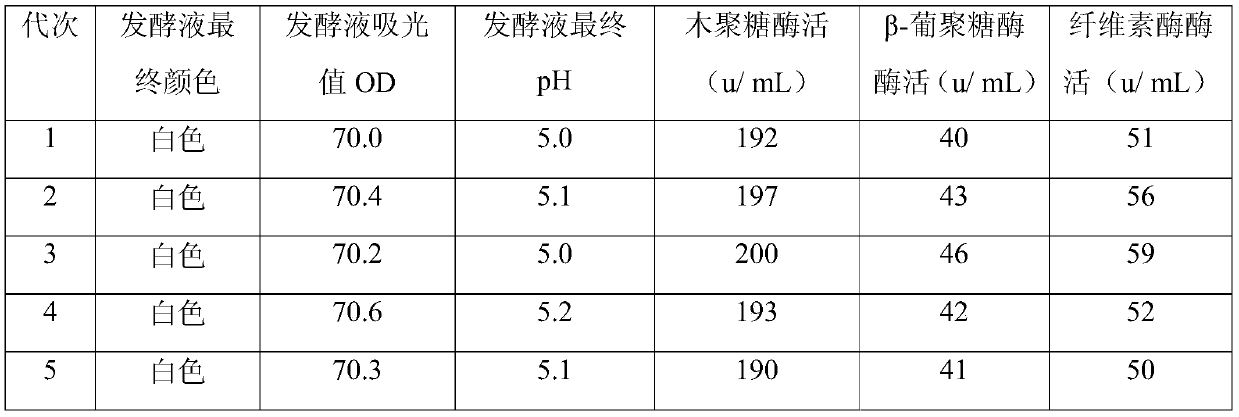Ensiling method of sugarcane waste leaves
A technology for sugarcane tail leaves and sugarcane tails is applied in the field of silage of sugarcane tail leaves, which can solve the problems of insufficient utilization of the nutritional value of silage quality and the like.
- Summary
- Abstract
- Description
- Claims
- Application Information
AI Technical Summary
Problems solved by technology
Method used
Image
Examples
Embodiment 1
[0028] 1 Aspergillus oryzae (Aspergillus oryzae) XMS01 strain acquisition and naming:
[0029] The present invention is to obtain a mutant strain of Aspergillus oryzae after carrying out mutagenesis to a starting strain of Aspergillus oryzae preserved in the laboratory, which has been identified and preserved through microbial taxonomy: named Aspergillus oryzae (Aspergillusoryzae) XMS01, CCTCC NO: M 2018425; the preservation place is: Wuhan University, Wuhan, China; the China Collection Center for Type Cultures, and the preservation time is July 02, 2018.
[0030] The source of Aspergillus oryzae in this laboratory: the starting strain is a strain of Aspergillus oryzae preserved in our laboratory, the xylanase activity in the fermentation supernatant of the starting strain Aspergillus oryzae is 40.2u / mL, and the β-glucanase activity 12.4u / mL, cellulase activity 16.3u / mL.
[0031] The morphological characteristics of Aspergillus oryzae (Aspergillus oryzae) XMS01 with high-yiel...
Embodiment 2
[0062] A kind of silage method of sugarcane tail leaf, concrete steps are as follows:
[0063] The first step: Aspergillus oryzae (Aspergillus oryzae) XMS01 needs to prepare the inoculum before the aerobic silage fermentation treatment. The specific method is: use the high-salt Caspian medium to activate the plane medium, and then use the MRS medium to configure it. After high-temperature sterilization for 30 minutes, cool to room temperature, inoculate Aspergillus oryzae (Aspergillusoryzae) XMS01 by 3% inoculum amount, place in an incubator after mixing and cultivate for 2 days, and the temperature is controlled at 37° C.;
[0064] Lactobacillus plantarum (Lactobacillus plantarum) XMS02 and said plant Lactobacillus (Lactobacillus plantarum) XMS03MRS need to carry out inoculum preparation before carrying out anaerobic silage fermentation treatment. The specific method is: use high-salt Caspian culture medium to carry out plane medium activation treatment , then use the MRS med...
Embodiment 3
[0072] A kind of silage method of sugarcane tail leaf, concrete steps are as follows:
[0073] The first step: Aspergillus oryzae (Aspergillus oryzae) XMS01 needs to prepare the inoculum before the aerobic silage fermentation treatment. The specific method is: use the high-salt Caspian medium to activate the plane medium, and then use the MRS medium to configure it. After high-temperature sterilization for 30 minutes, cool to room temperature, inoculate Aspergillus oryzae (Aspergillusoryzae) XMS01 by 3% inoculation amount, place in an incubator after mixing and cultivate for 2.5 days, and the temperature is controlled at 37° C.;
[0074] Lactobacillus plantarum (Lactobacillus plantarum) XMS02 and said plant Lactobacillus (Lactobacillus plantarum) XMS03MRS need to carry out inoculum preparation before carrying out anaerobic silage fermentation treatment. The specific method is: use high-salt Caspian culture medium to carry out plane medium activation treatment , then use the MR...
PUM
 Login to View More
Login to View More Abstract
Description
Claims
Application Information
 Login to View More
Login to View More - R&D
- Intellectual Property
- Life Sciences
- Materials
- Tech Scout
- Unparalleled Data Quality
- Higher Quality Content
- 60% Fewer Hallucinations
Browse by: Latest US Patents, China's latest patents, Technical Efficacy Thesaurus, Application Domain, Technology Topic, Popular Technical Reports.
© 2025 PatSnap. All rights reserved.Legal|Privacy policy|Modern Slavery Act Transparency Statement|Sitemap|About US| Contact US: help@patsnap.com



